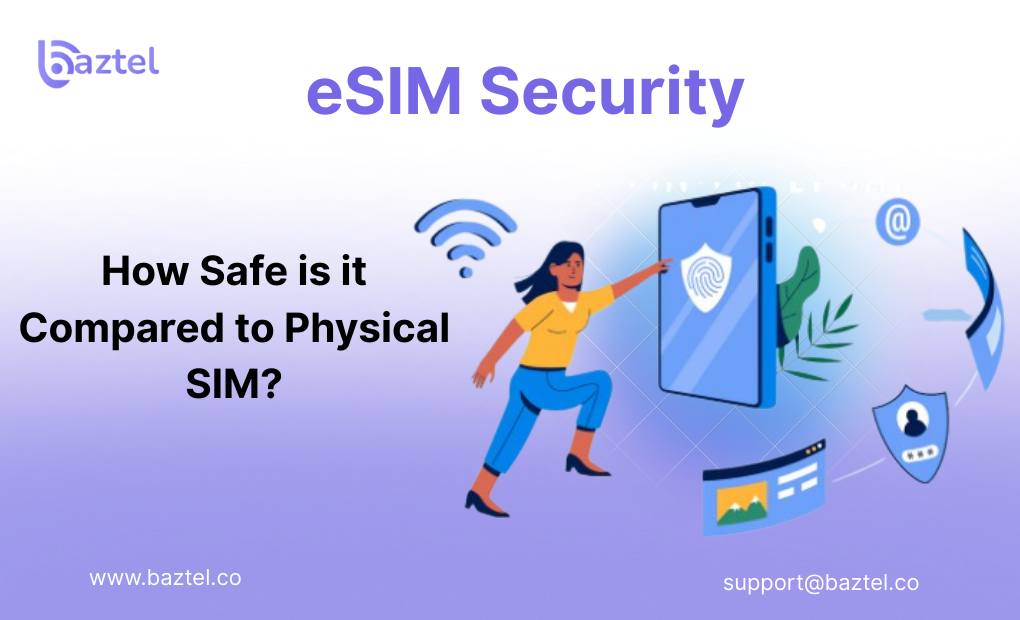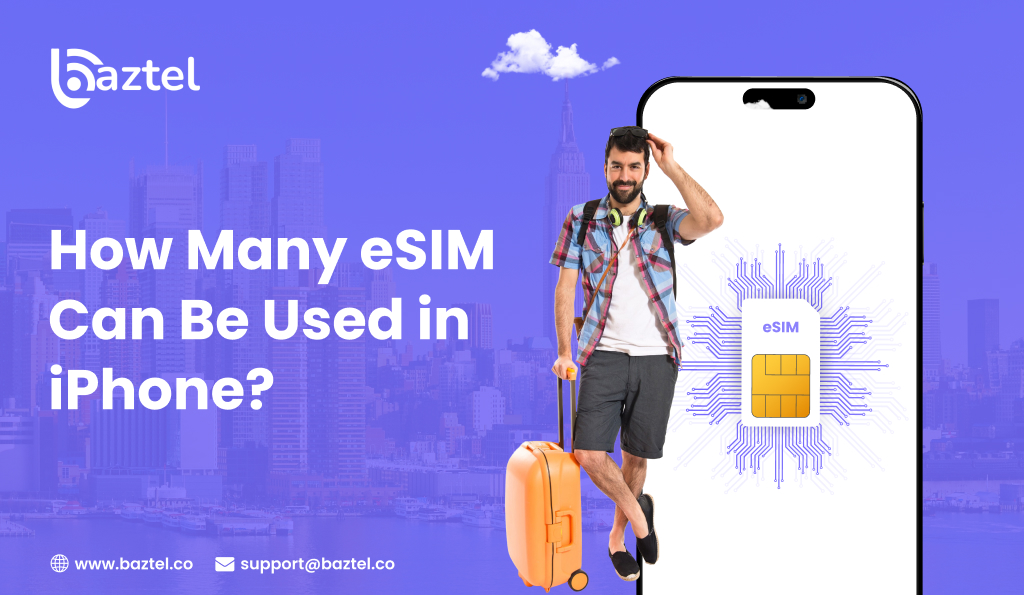As smartphones move toward a more digital future, eSIMs are replacing the tiny plastic SIM cards we’ve used for decades. But with this shift comes a valid concern: how secure is an eSIM compared to a physical SIM? Is this digital version more protected or just another tech trend?
In this guide, we’ll understand everything related to eSIM security such as is eSIM safe and how it is different from regular SIMs. Whether you’re considering a switch or just curious, we’ll help you understand the risks, benefits, and real-life protections around eSIMs.
We’ll also answer user queries like:
- Is eSIM safe for travelers?
- What if your eSIM phone gets stolen?
- Can someone hack or clone your eSIM?
We’ll explain tech facts in simple language for better understanding and include expert sources at the same time.
Understanding eSIMs
An eSIM is a digital SIM that’s already built into your phone, smartwatch, or tablet. Unlike traditional SIM cards, there is no need to insert or remove anything physically. Instead, your carrier sends a digital activation profile, which can be downloaded over Wi-Fi or mobile data.
It performs all the same functions as a physical SIM:
- Stores your mobile network details
- Enables you to connect to cellular services
- Allows number portability and plan switching
But here’s what makes eSIMs smarter and more secure:
- The profile is rewritable. You can delete, switch, or update carriers without needing a new chip.
- Your eSIM is locked to your device, meaning it can’t be used in another phone if stolen.
- Many phones allow multiple eSIM profiles. It is helpful for travel or work numbers.
Learn more in our blog on how eSIM works and how to activate it.
For official documentation, you can also refer to the GSMA eSIM Specification Overview a global standard followed by carriers and manufacturers.
eSIM vs SIM Security: Which Is Safer?
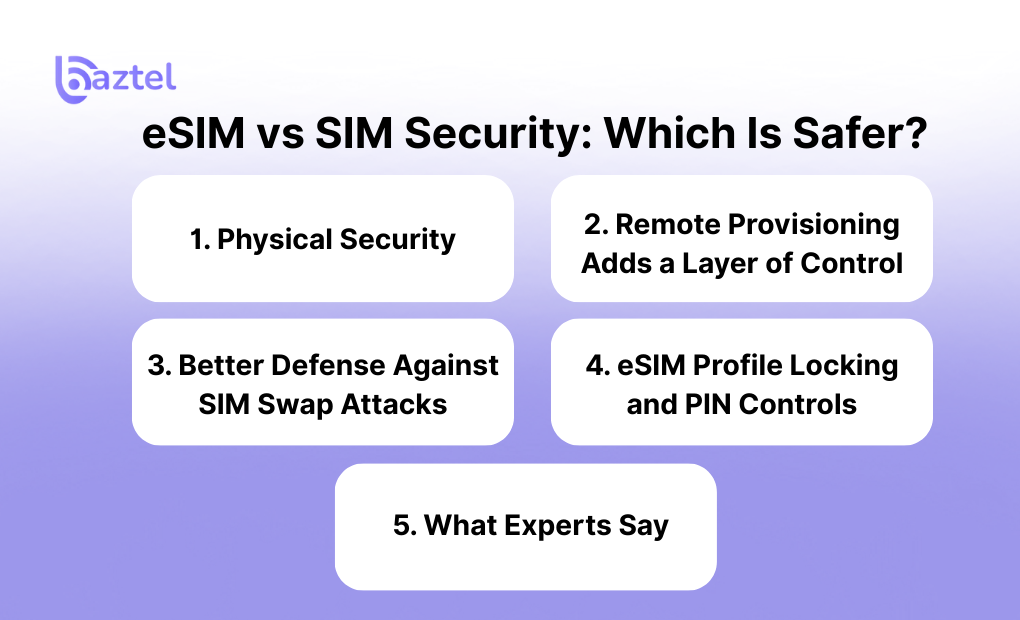
Digital security is one of the biggest concerns around the globe. Especially, when it is related to rising cases of SIM swap fraud, identity theft, and phishing. So, if you’re planning to switch from a traditional SIM to an eSIM, it is essential to understand the security differences between eSIM vs SIM Security.
Let’s break it down clearly.
1. Physical Security
With a traditional SIM card, if your phone is lost or stolen, it’s quite easy for someone, with simple physical access, to take the SIM out of your phone, put it into another phone, and take over your number as quickly as possible.
In contrast, an eSIM is embedded directly into your phone’s motherboard, making physical theft of the card impossible. There is no tray to open, and there is no card to remove. If someone steals your phone, they can’t just remove the eSIM.
This is a major hardware-level advantage that makes eSIM more secure than a physical SIM card.
2. Remote Provisioning Adds a Layer of Control
eSIM profiles are activated and managed digitally. This means:
- You need a verified QR code or carrier-issued download link to install a new profile.
- Many carriers add an additional layer of security, usually some form of two-factor authentication (2FA) for eSIM activation.
- Some phones such as Google Pixel and iPhones allow only account holders to transfer eSIM profiles or devices.
This significantly increases the difficulty of a bad actor replicating your number without your knowledge.
For a deeper dive into how activation works, check our guide: How long does it take to activate eSIM?
3. Better Defense Against SIM Swap Attacks
SIM swap fraud is one of the most destructive mobile threats today. In this case, a bad actor obtains a new SIM that they can control, and with a SIM swapping, makes the telephone carrier assign your own telephone number to the bad actor’s SIM. That possession opens access to One-Time Passcodes (OTP) in addition to bank logins and account access.
With eSIM, the activation journey is more secure. Most carriers require:
- Strong ID verification.
- Approval via official apps or customer portals.
- Real-time alerts when changes are requested.
This makes eSIM accounts more resistant to social engineering tactics, a common method used in SIM swap scams.
Need help protecting your number in the U.S.? Refer to the FCC’s SIM swap scam protection page for steps and safety tips.
4. eSIM Profile Locking and PIN Controls
Modern devices allow users to:
- Set PIN codes on their eSIM profiles.
- Lock eSIM profiles so they can’t be deleted without authentication.
- Disable remote SIM profile management if needed.
This is especially useful for travelers and professionals carrying sensitive data giving complete control over how and when your eSIM can be changed.
5. What Experts Say
According to a 2024 report by GSMA Intelligence, the global shift to eSIM is driven partly by its improved security features. Most enterprise-level device management systems now prefer eSIMs for mobile workforce management due to better tracking, fewer physical vulnerabilities, and stricter provisioning controls.
TL;DR: Is eSIM More Secure Than SIM?
Yes. Here’s why:
- Cannot be removed physically.
- Difficult to clone or swap without proper authentication.
- Alerts and logs give you full control.
- Less vulnerable to social engineering.
No system is impenetrable to hacks, but eSIM offers more inherent protections than a SIM card does. If you maintain your device and carrier account, then eSIM is a better move for digital security.
Is eSIM Safe for International Travel?
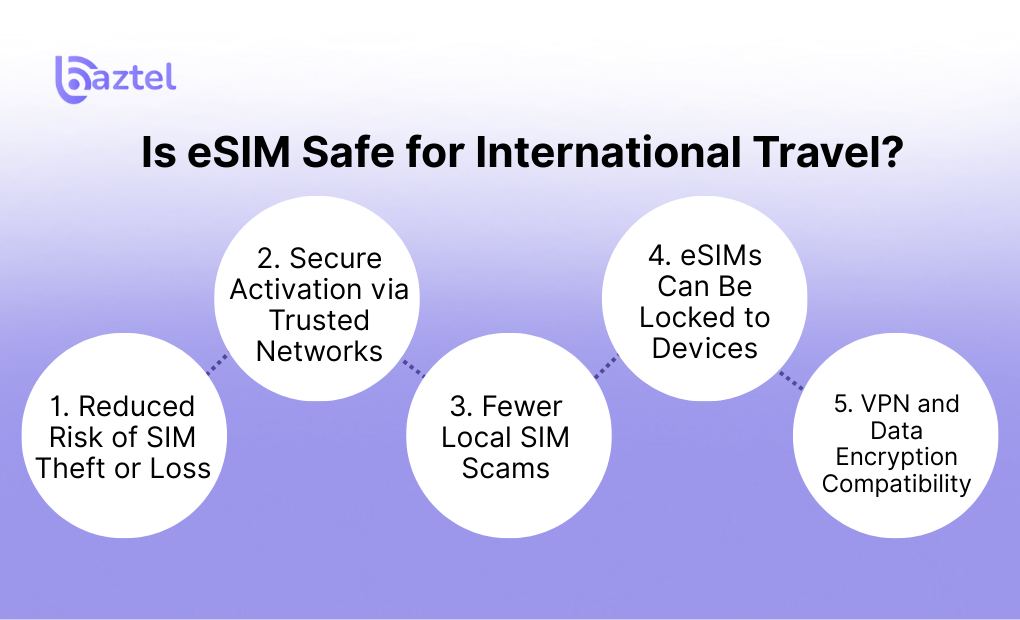
If you are a frequent flyer or digital nomad, you have heard that eSIM is the next frontier for global connectivity. But aside from the convenience of easily switching plans or dodging roaming charges, is this the future of global connectivity? The question is:
Is eSIM safe when you’re traveling abroad?
The short answer is: Yes and in many ways, it’s safer than using physical SIMs. Let’s explore why.
1. Reduced Risk of SIM Theft or Loss
When you travel, your phone becomes your lifeline for maps, hotel bookings, OTPs, and even payments. Losing a SIM card abroad can lock you out of everything. Worse, if someone else finds it, they can misuse it.
eSIM offers nothing to steal. Your eSIM profile is encapsulated in the phone’s hardware and is not susceptible to tampering, even in crowded areas or transit points. This alone makes eSIM a much safer solution for any traveler who cannot take a chance on connectivity interruption.
2. Secure Activation via Trusted Networks
Most eSIM plans for international travel are activated via QR code or app-based provisioning often requiring email or phone verification. These steps act as natural filters against scams or fake plans sold through shady vendors.
Many platforms like Baztel now require identity confirmation before issuing eSIMs for global use. This ensures the number is tied to the real user and not easily transferable or abusable.
3. Fewer Local SIM Scams
Scammers at tourist spots often offer cheap local SIMs but these can be preloaded with malware or spyware. Since eSIM works with pre-approved carriers and verified app stores, the risk of encountering these scams goes down drastically.
You’re no longer dependent on street kiosks or airports to stay connected, just install your eSIM from your chosen provider before your trip and land with active data.
4. eSIMs Can Be Locked to Devices
If your phone gets lost or stolen abroad, most eSIMs are:
- Tied to a specific device’s EID (eSIM ID).
- Protected by PIN codes or profile locks.
- Deactivatable remotely through your carrier dashboard or app.
This makes it harder for thieves to access your number, unlike physical SIMs which can be instantly removed and reused.
5. VPN and Data Encryption Compatibility
Most providers of eSIM to travelers support connections on secure networks. Again making it possible for you to couple your international eSIM with a VPN to further encrypt your traffic, avoid data throttling, and protect sensitive transactions when using public Wi-Fi.
This makes eSIM a capable choice for banking, emails, and remote work while abroad.
TL;DR: Why eSIM Is Safe for Global Travel
- No SIM card to lose, steal, or damage.
- Activation tied to verified identities.
- Reduced chances of local SIM fraud.
- Can be locked, erased, or managed remotely.
- Works well with VPNs and secure protocols.
In short, if security is a concern while you are traveling/eSIM is a more secure means of getting connected and moving to eSIM is not just a convenience, it is smarter security.
Common eSIM Security Risks and How to Avoid Them
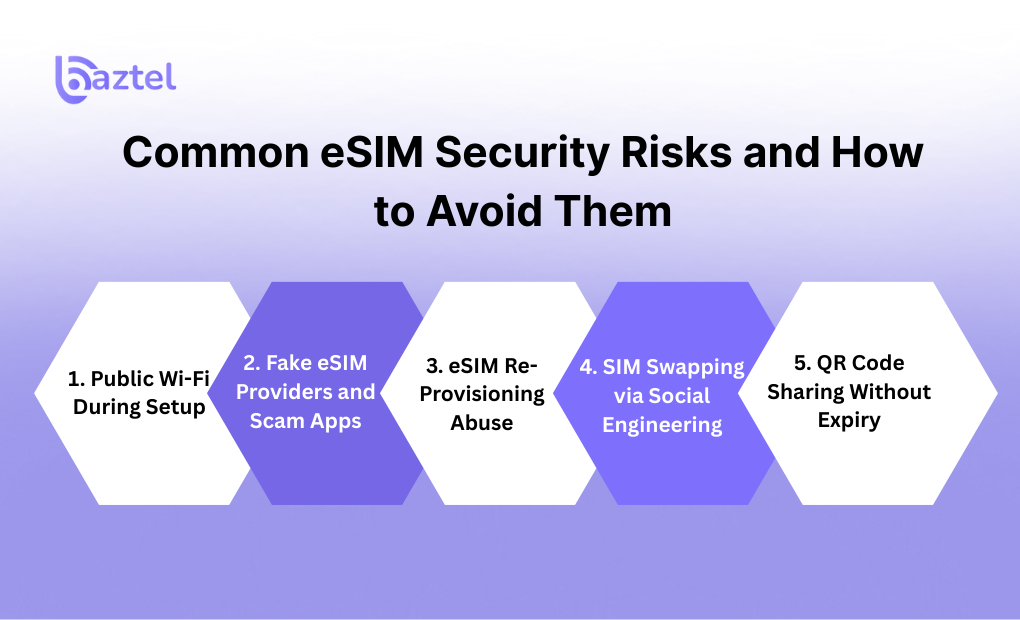
While eSIM technology adds several layers of security, it’s not 100% risk-free. Like any digital system, it can be misused especially if you don’t follow basic security hygiene. Let’s break down the most common eSIM security threats and how you can stay protected.
1. Public Wi-Fi During Setup
Many users download and activate eSIMs while using hotel Wi-Fi or airport hotspots both known for weak encryption. This can expose your eSIM QR code or app session to interception.
What You Can Do:
- Use a VPN when downloading or activating your eSIM.
- Prefer mobile data or a secure Wi-Fi source for setup.
- Never share QR codes publicly or over unsecured chats.
2. Fake eSIM Providers and Scam Apps
Cybercriminals can spoof legitimate brands and create fake websites or apps to trick users into downloading malicious eSIM profiles. These may harvest personal data or control device settings.
What You Can Do:
- Stick to verified providers listed on GSMA or well-known stores.
- Always check the URL and reviews before downloading any app.
- Do a quick Google search like “Is XYZ eSIM legit?” if you’re unsure.
Related Reading: A Complete Guide to the Best eSIM Cards for Travelers
3. eSIM Re-Provisioning Abuse
Some advanced attacks target the re-provisioning process where an eSIM profile is deleted and replaced with a new one. If a hacker gains remote access to your phone or carrier account, they might attempt this swap to hijack your number.
What You Can Do:
- Enable device-level security like passcodes or biometrics.
- Use two-factor authentication (2FA) for your carrier account.
- Never give eSIM or device credentials to customer support agents without verification.
4. SIM Swapping via Social Engineering
While eSIMs reduce the chance of physical SIM theft, the risk of social engineering attacks still exists. In some cases, attackers have convinced carriers to activate a new eSIM on their device using fake IDs or support tickets.
What You Can Do:
- Add a port-out PIN to your mobile account.
- Choose eSIM providers that offer support verification steps before profile changes.
- Monitor your email and phone for suspicious login attempts.
5. QR Code Sharing Without Expiry
Some providers send one-time-use QR codes, but others don’t. If you save that QR code on cloud storage or share it via email, anyone who accesses it later could misuse it.
What You Can Do:
- Delete eSIM QR codes after activation.
- Avoid storing them in cloud drives without encryption.
- Use providers that auto-expire QR codes after the first scan.
Final Tip: eSIM Doesn’t Replace Common Sense
Even with eSIM’s built-in protections, your habits make the biggest difference. Treat your eSIM profile like a bank password. Don’t share it. Don’t store it carelessly. And always choose providers that prioritize user identity verification and encryption.
You’re not just using digital SIMs, you’re adopting a secure-first approach to connectivity.
eSIM Security vs Physical SIM: Which Is More Secure in 2025?
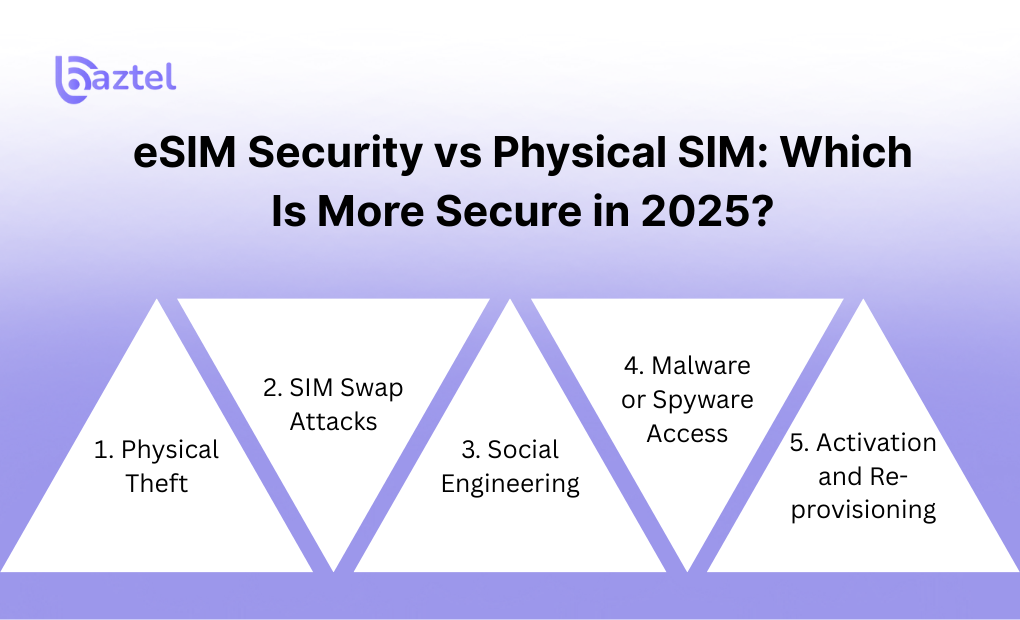
Many users assume physical SIMs are safer just because they’re tangible. But in reality, physical doesn’t always mean more secure. eSIMs introduce a new layer of digital protection that traditional SIM cards can’t match, especially in a post-pandemic, remote-first world where cyber hygiene matters more than ever.
Let’s compare the security of eSIM vs physical SIM from all angles that matter.
1. Physical Theft
Physical SIM: If someone steals your phone, they can remove the SIM card, insert it into another device, and access your OTPs or messages.
eSIM: There’s no removable chip. The profile is tied to the device and protected by PIN, Face ID, or fingerprint.
Winner: eSIM your number stays locked even if your phone is lost or stolen.
2. SIM Swap Attacks
Physical SIM: Swapping your number to another SIM is easy, sometimes too easy. Social engineering attacks trick carriers into porting your number.
eSIM: Many eSIM providers have stricter re-verification steps like QR code expiration, login OTP, or app-based profiles.
Winner: eSIM less prone to unauthorized number transfers.
3. Social Engineering
Physical SIM: Attackers can walk into a store with fake documents and request a new SIM linked to your number.
eSIM: While not immune, eSIM onboarding is more digital and requires multiple authentication layers making it harder to manipulate.
Winner: eSIM more checks and fewer loopholes.
4. Malware or Spyware Access
Physical SIM: Less exposed digitally, but once inserted into an infected phone, it can still be misused.
eSIM: Stored on the phone’s secure element (hardware-protected chip), making it much harder to tamper with via spyware or rootkits.
Winner: eSIM stronger resistance to malware-level access.
5. Activation and Re-provisioning
Physical SIM: Any person with physical access can remove and replace the SIM no trace left.
eSIM: Re-provisioning needs carrier approval, QR codes, or app-based control, and often gets logged.
Winner: eSIM adds traceability and verification steps.
Final Verdict: eSIM Is Safer If You Use It Right
eSIM wins in most categories because it removes the physical layer of vulnerability. But security also depends on you:
- Don’t share your eSIM QR codes
- Avoid shady providers
- Use biometric protection on your phone
Also read:
→ How to Transfer an eSIM from One Android Phone to Another
→ How Long Does It Take to Activate eSIM?
→ What Is an eSIM Card and How Does It Work?
Best Practices to Maintain eSIM Security
While eSIMs offer better built-in protection than physical SIMs, they’re not immune to threats. Just like you wouldn’t leave your phone unlocked in a public place, your eSIM profile also needs basic hygiene to stay secure especially if you’re switching devices or using public networks while traveling.
Below are simple, practical steps to keep your eSIM safe in 2025:
1. Lock Your Phone with a Strong PIN or Biometric
Always use Face ID, fingerprint, or a 6-digit passcode. Your eSIM is tied to the phone’s secure element but if your phone is unlocked, it can still be accessed by intruders.
Pro Tip: Avoid 1234, 0000, or birthdate combos; these are easy to guess.
2. Never Share Your eSIM QR Code
QR codes are like digital keys to your eSIM profile. Sharing them is like handing out your SIM card.
- Don’t screenshot and send it on WhatsApp
- Don’t save it in your gallery without password protection
- Avoid printing it unless it’s temporary
Use cloud vaults or password managers if you need to store it.
3. Revoke or Delete eSIM When Switching Devices
When you change phones, delete the old eSIM profile before selling or recycling the phone.
- On iPhones: Go to Settings > Mobile Data > Remove eSIM
- On Android: Settings > Connections > SIM Manager > Delete
This ensures no one else can re-use your number.
4. Choose Trusted eSIM Providers Only
Stick to eSIMs from reputed carriers or verified platforms. Fly-by-night apps can log your number, sell your usage data, or leave you vulnerable to SIM swap attacks.
External tip: You can check eSIM provider ratings on Trustpilot or forums like Reddit r/eSIM.
5. Enable 2FA on Your Carrier Account
If your eSIM is linked to a carrier login or app, turn on 2-factor authentication (2FA). This prevents someone from accessing your account and remotely triggering an eSIM transfer.
- Use OTP via email/SMS
- Or use authenticator apps like Google Authenticator
6. Don’t Ignore Suspicious SMS or Login Attempts
If you get OTPs you didn’t request, or alerts like “SIM profile activation in progress,” take immediate action:
- Reset your password
- Contact your carrier
- Remove the eSIM if needed
Read more: Troubleshooting eSIM QR Code Issues
Bonus Tip: Avoid eSIM Setup on Public WiFi
Setting up or activating your eSIM on airport or café WiFi? That’s risky. Attackers can spoof the network and intercept your QR code or carrier login.
Use a personal hotspot or VPN during setup.
Real-World Cases Where eSIM Security Helped or Failed
Security isn’t just about features, it’s about what happens in real life. Below are real-world examples that highlight how eSIM technology has both protected users and, in rare cases, been compromised.
When eSIM Security Prevented SIM Swap Attacks
In 2023, a Reddit user from Europe shared that his phone was targeted by scammers trying to clone his number. While his friend with a physical SIM got SIM swapped and lost access to banking apps, his eSIM remained secure. Why? Because:
- His eSIM was tied to Face ID and device-only access
- Carrier required OTP + biometric to approve remote transfer
- No physical SIM meant nothing could be removed from the phone
Lesson: A locked eSIM tied to a secure device is harder to exploit than a removable SIM.
When eSIM Setup Was Exploited
On the flip side, in early 2024, some users from the US reported cases where hackers gained access to their carrier login and activated a new eSIM remotely. This allowed the attacker to:
- Receive OTPs for banking and Gmail
- Lock the original user out of the account
- Trigger financial fraud within minutes
In most of these cases, the weak link was not the eSIM but poor account protection like no 2FA, or using easy-to-guess passwords.
Related internal read: How Long Does It Take to Activate eSIM?
eSIM Proved Useful for Travelers with Lost Phones
A travel blogger documented on YouTube how she lost her iPhone in Thailand. But because her eSIM profile was backed up and secured via iCloud:
- She restored her number to a new iPhone within minutes
- Activated travel data again without visiting a store
- Logged into her bank and email safely
Reference: Apple Support – Using eSIM with iPhone
This shows the value of remote eSIM recovery, which is impossible with a lost physical SIM.
Poor Implementation by Some eSIM Providers
Not all eSIM apps are equal. Some shady providers don’t verify customer identity, allow easy QR re-issuance, and store profiles in unsecured systems. In one reported case:
- An eSIM provider’s leaked database exposed hundreds of QR codes
- Hackers used these to clone eSIM profiles
- Victims lost network access and personal data
Avoid random or “too cheap to be true” eSIM services.
eSIM vs SIM Security: Comparison Table
To truly understand how safe eSIMs are, let’s compare them with traditional physical SIM cards across key security areas.
| Feature/Aspect | eSIM Security | SIM Card Security |
| Physical Theft Risk | Very low (embedded, can’t be removed) | High (can be removed or cloned if stolen) |
| SIM Swap Attacks | Harder if eSIM is locked and carrier uses strict KYC | Easier physical swap or social engineering is common |
| QR Code Exploits | Possible if QR is leaked and reused | Not applicable |
| Data Encryption | eSIM data often encrypted and tied to device | Depends on carrier; not device-tied |
| Remote Activation Risk | Risk if account credentials are weak | Less prone, needs physical SIM request |
| Backup & Recovery | Cloud backups possible via iOS/Android security layers | No remote backup option |
| Multiple Profiles | Supports multiple eSIMs for travel or business use | One SIM per slot only |
| Tamper Proof | Yes – eSIM is soldered into device | No – SIM card can be duplicated or swapped |
| User Control | High – can delete, lock, or move profiles securely | Moderate – needs manual removal |
| Security in Transit | Encrypted provisioning over secure carrier channels | Physical delivery risk |
eSIMs don’t make your phone invincible, but when implemented with strong carrier policies, 2FA, and device locks, they provide a more secure alternative to physical SIMs in most real-world situations.
Related Internal Reads:
Final Thoughts on eSIM Security
eSIM technology isn’t just a trend, it’s a real upgrade in mobile security when compared to physical SIM cards. While both have vulnerabilities, eSIMs reduce physical risks, offer stronger remote management, and increase user control.
But like any tech, security depends on how you use it:
- Lock your device with a strong password or biometrics
- Don’t share your QR codes or eSIM credentials
- Use 2FA with your carrier or eSIM provider
- Avoid unsecured apps or third-party eSIM marketplaces
Whether you’re traveling or using it for business, eSIMs offer a safer, smarter way to stay connected as long as you’re aware of best practices.
Frequently Asked Questions (FAQs)
Is eSIM safer than a physical SIM?
Yes, in most cases. eSIMs can’t be physically removed or cloned, making them less prone to theft and SIM swap fraud.
What happens if someone steals my phone with an eSIM?
They can’t easily remove your eSIM or put it in another phone. If you use a strong screen lock and remote-wipe features (like “Find My Device” or iCloud), your data stays protected.
Can someone hack my eSIM?
Hacking an eSIM is difficult, especially if you’re using official carrier apps or secure provisioning. Avoid third-party sites and always reset your credentials if compromised.
Can I deactivate my eSIM remotely?
Yes. Most providers let you log in to your account and disable the eSIM remotely. You can also contact customer support for manual deactivation.
Is it safe to use an eSIM while traveling internationally?
Yes. In fact, it’s more secure than buying a local SIM from unknown vendors. Just choose a reliable international eSIM provider with good reviews and security protocols.
Blog Author
Peter
Peter started BazTel.co to make mobile internet easier for travellers. He noticed how tough it was to find good network options while visiting new countries. That’s when he built BazTel — a place where anyone can buy eSIMs online without confusion or long steps. He believes tech should be simple and useful, not complicated. When he’s free, he likes to travel, test BazTel himself, and keep improving it based on real user problems.

 Botswana
Botswana Zambia
Zambia Congo
Congo Colombia
Colombia China mainland
China mainland Chile
Chile Chad
Chad Central African Republic
Central African Republic Canada
Canada Cameroon
Cameroon Cambodia
Cambodia Burkina Faso
Burkina Faso Bulgaria
Bulgaria Brunei Darussalam
Brunei Darussalam Brazil
Brazil Aland Islands
Aland Islands Bosnia and Herzegovina
Bosnia and Herzegovina Bolivia
Bolivia Belgium
Belgium Belarus
Belarus Bangladesh
Bangladesh Bahrain
Bahrain Azerbaijan
Azerbaijan Austria
Austria Australia
Australia Armenia
Armenia Argentina
Argentina Algeria
Algeria